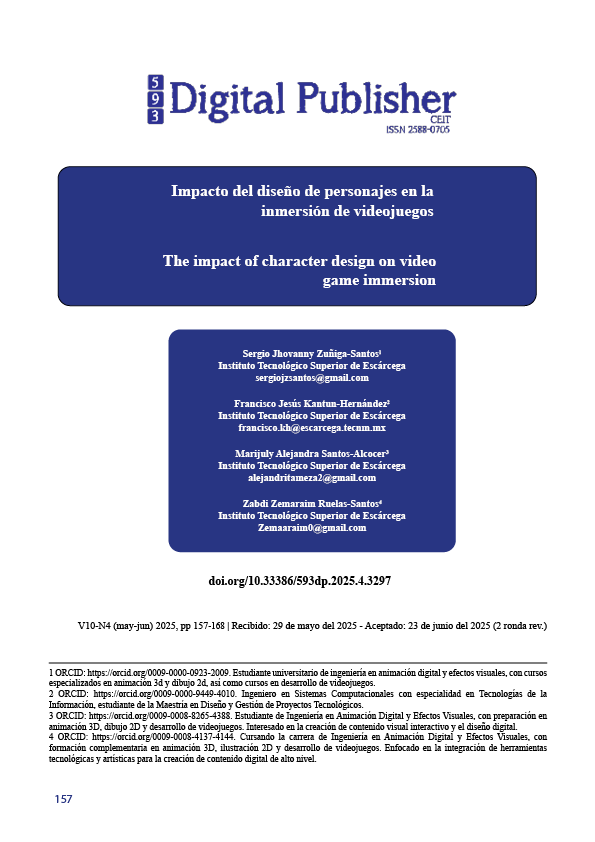The impact of character design on video game immersion
Main Article Content
Abstract
This research analyzes how character design influences immersion in video games, emphasizing that it is not just about aesthetics, but a key narrative tool. Through a systematic review using the PRISMA method, 617 articles were collected and analyzed, of which 50 met the inclusion and quality criteria, such as relevance to the topic, corroborated data, full-text availability, among others. The study identifies four main axes: immersion in video games, animation, character design, and user psychology. Based on the selected articles, it concludes that coherent and emotionally resonant character design (including silhouette, colors, clothing, and expressions) strengthens the player's connection. Additionally, a character’s narrative development, visual context, and integration within the game environment significantly contribute to an immersive experience. According to the reviewed research, characters like Lara Croft and Kratos have become cultural icons due to their consistent and meaningful design. The paper also warns about the commercialization of art in video games, which can lead to generic and hollow characters focused on quick sales, undermining authenticity and the player’s experience. It highlights the importance of balancing design and gameplay to maintain the coherence of the virtual world.
This work emphasizes that character design not only brings a video game to life, but largely determines its ability to emotionally connect with the player and sustain narrative immersion.
Downloads
Article Details

This work is licensed under a Creative Commons Attribution-NonCommercial-ShareAlike 4.0 International License.
1. Derechos de autor
Las obras que se publican en 593 Digital Publisher CEIT están sujetas a los siguientes términos:
1.1. 593 Digital Publisher CEIT, conserva los derechos patrimoniales (copyright) de las obras publicadas, favorece y permite la reutilización de las mismas bajo la licencia Licencia Creative Commons 4.0 de Reconocimiento-NoComercial-CompartirIgual 4.0, por lo cual se pueden copiar, usar, difundir, transmitir y exponer públicamente, siempre que:
1.1.a. Se cite la autoría y fuente original de su publicación (revista, editorial, URL).
1.1.b. No se usen para fines comerciales u onerosos.
1.1.c. Se mencione la existencia y especificaciones de esta licencia de uso.
References
Augusto, C. D. R. (2025, 1 enero). Diseño y desarrollo de un videojuego en realidad virtual: rigging y animación de personajes y objetos. https://dspace.ups.edu.ec/handle/123456789/29776
Castro Cisternas, N. (2024).El arte de dar vida : el diseño de personajes como núcleo en la animación. URI: https://repositorio.uchile.cl/handle/2250/202883
Antonio, C. S. J., & Manuel, C. M. J. (2024). Arquetipos y estereotipos: análisis del diseño de personajes vinculados a los roles dentro de los videojuegos. Dialnet. https://dialnet.unirioja.es/servlet/dctes?codigo=347832
González López, L. (2022). Haze. Diseño de personajes y props para un videojuego. Universitat Politècnica de València. https://riunet.upv.es/handle/10251/184544
Terol Martínez, E.(2022) Diseño de personajes para videojuegos. https://hdl.handle.net/11000/28073
Barrero, L. I. (2024). Didáctica del color en escenarios del videojuego. Influencias de la neuroarquitectura y el cine. Dialnet. https://dialnet.unirioja.es/servlet/articulo?codigo=9916780
Mercado, N. B. (2021). Ilustración: entre el arte y el diseño. Papeles de Cultura Contemporánea Hum736, (24), 09-34.https://doi.org/10.30827/pcc.vi24.25378
Chhatre, K., Athanasiou, N., Becherini, G., Peters, C., Black, M. J., & Bolkart, T. (2024). Emotional speech-driven 3d body animation via disentangled latent diffusion. In Proceedings of the IEEE/CVF Conference on Computer Vision and Pattern Recognition (pp. 1942-1953).https://openaccess.thecvf.com/content/CVPR2024/html/Chhatre_Emotional_Speech-driven_3D_Body_Animation_via_Disentangled_Latent_Diffusion_CVPR_2024_paper.html
Oltra, A. G. (2020). La revolución de los píxeles: arte y videojuegos en un mundo digital. Dialnet. https://dialnet.unirioja.es/servlet/articulo?codigo=7491223
Teng, C. I., Huang, T. L., Huang, G. L., Wu, C. N., Cheng, T. C. E., & Liao, G. Y. (2024). Creatability, achievability, and immersibility: New game design elements that increase online game usage. International Journal of Information Management, 75, 102732.https://www.sciencedirect.com/science/article/pii/S0268401223001135
Kolosnichenko, M., Kolisnyk, O., Gula, Y., Dubrivna, A., & Nikolayeva, T. (2022). Graphic design as an indicator of social transformations. Revista de la Universidad del Zulia, 13(38), 893-915.https://dialnet.unirioja.es/servlet/articulo?codigo=8810181
González de Ávila, M. (2022). Cognición y semiosis. El sujeto que piensa es el mismo que significa. Tropelias: Revista de teoría de la literatura y literatura comparada, 38(38), 25-43.https://gredos.usal.es/handle/10366/156431
Rönkkö, A. (2021). Psychology at play: Empathy and Character Relatability.https://www.theseus.fi/handle/10024/498019
Yusof, N. A., Mastor, K. A., Haron, H., Keng, L. K., Alias, J., Mamat, M., & Salleh, A. R. (2022). The Influence of Anime on The Moral Value among Arts and Design Students: A Pilot Study in Uitm Shah Alam. International Journal of Academic Research in Business and Social Sciences,https://hrmars.com/papers_submitted/14748/the-influence-of-anime-on-the-moral-value-among-arts-and-design-students-a-pilot-study-in-uitm-shah-alam.pdf
Cao, X., Watanabe, M., & Ono, K. (2021). How Character-Centric Game Icon Design Affects the Perception of Gameplay. Applied Sciences, 11(21), 9911. https://doi.org/10.3390/app11219911
Page, M. J., McKenzie, J. E., Bossuyt, P. M., Boutron, I., Hoffmann, T. C., Mulrow, C. D., Shamseer, L., Tetzlaff, J. M., Akl, E. A., Brennan, S. E., Chou, R., Glanville, J., Grimshaw, J. M., Hróbjartsson, A., Lalu, M. M., Li, T., Loder, E. W., Mayo-Wilson, E., McDonald, S., … Moher, D. (2021). The PRISMA 2020 statement: An updated guideline for reporting systematic reviews. Systematic Reviews, 10(1), 89.https://doi.org/10.1016/j.recesp.2021.06.016
Thompson, J. R., Liu, Z., & Stasko, J. (2021, May). Data animator: Authoring expressive animated data graphics. In Proceedings of the 2021 CHI Conference on Human Factors in Computing Systems (pp. 1-18).https://dl.acm.org/doi/abs/10.1145/3411764.3445747
Isbister, K. (2022). Better Game Characters by Design: A Psychological Approach (1st ed.). CRC Press. https://doi.org/10.1201/9780367807641
Palomino, P. S. (2024). La construcción del personaje dramático y su influencia en la formación social. Revista Educación, 22(24), 63-72. https://doi.org/10.51440/unsch.revistaeducacion.2024.24.497
Rosyid, D. F., & Maulina, R. (2022). Character design of eren yeager in animated attack on Titan series from season 1-4. In Proceeding of International Conference on Business, Economics, Social Sciences, and Humanities (Vol. 5, pp. 482-489).https://www.researchgate.net/profile/Dzulfiqar-Rosyid/publication/368881865_Character_Design_of_Eren_Yeager_In_Animated_Attack_on_Titan_Series_from_Season_1-4/links/63ff3b230cf1030a5660c29d/Character-Design-of-Eren-Yeager-In-Animated-Attack-on-Titan-Series-from-Season-1-4.pdf
Sancán Lapo, M. (2023). Narrativa, Mecánicas de Videojuegos y Animación como Fortalezas Interactivas para Videojuegos en Móviles. Revista Politécnica http://scielo.senescyt.gob.ec/scielo.php?script=sci_arttext&pid=S1390-01292023000100007
Griffiths, M. D. (2020). Adicción a los videojuegos: una revisión de la literatura. Psicología Conductual https://www.behavioralpsycho.com/wp-content/uploads/2020/04/08.Griffiths_13-3oa-1.pdf
Bowman, N. D., Rieger, D., & Lin, J. T.22). Social video gaming and well-being. Current Opinion in Psychology, 45, 101316
.Chang, C. S., Chung, C. H., & Chang, J. A. (2020). Influence of problem-based learning games on effective computer programming learning in higher education. Educational Technology Research and Development, https://link.springer.com/article/10.1007/s11423-020-09784-3
García-Miranda, I., & Durán-Heras, A. D. (2020). Uso de videojuegos de simulación empresarial como complemento de aprendizaje en el área de Ingeniería de Organización.https://www.revistadyo.es/DyO/index.php/dyo/article/view/566
Hummel, H. G., Nadolski, R. J., Eshuis, J., Slootmaker, A., & Storm, J. (2021). Serious game in introductory psychology for professional awareness: Optimal learner control and authenticity. British Journal of Educational Technology,https://bera-journals.onlinelibrary.wiley.com/doi/full/10.1111/bjet.12960
Teng, Y. Y., Chou, W. C., & Cheng, M. T. (2021). Learning immunology in a game: Learning outcomes, the use of player characters, immersion experiences and visual attention distributions.
Tsai, M. H., Chang, Y. L., Shiau, J. S., & Wang, S. M. (2021). Exploring the effects of a serious game-based learning package for disaster prevention education: The case of Battle of Flooding Protection. International Journal of Disaster Risk Reduction
Wronowski, M., Urick, A., Wilson, A. S. P., Thompson, W., Thomas, D., Wilson, S., Elizondo, F. J., & Ralston, R. (2020). Effect of a Serious Educational Game on Academic and Affective Outcomes for Statistics Instruction. Journal of Educational Computing Research, 57(8), 2053-2084. https://doi.org/10.1177/0735633118824693
Lapo, M. E. S. (2020). Análisis del equilibrio gráfico-narrativo presente en la experiencia interactiva de los videojuegos. Con A de animación,(10), 94-111.https://dialnet.unirioja.es/servlet/articulo?codigo=7310650
Ore, L. U. R., Matos, J. L. M., & Tramontana, M. A. C. (2024). La influencia del diseño gráfico en la creación de personajes animados publicitarios. https://revistasucal.com/index.php/rca/article/view/106
Narváez Miranda, C. A. (2025). Diseño y desarrollo de un videojuego de realidad virtual: modelado y texturizado de escenarios y personajes (Bachelor’s thesis).
Serrano Gómez, R. (2020). Diseño y desarrollo de personajes con presencia social en videojuegos de realidad virtual.
Sánchez, M. R. J., Moreno, J. M. V., & Caro, K. (2022). Diseño de un videojuego para el aprendizaje de conceptos sobre el emprendimiento. Revista de Investigación en Tecnologías de la Información: RITI, 10(22), 31-48.https://dialnet.unirioja.es/servlet/articulo?codigo=8652920
Arenas, D., Atuesta, G., & Chanchí, G. E. (2020). Diseño e implementación de modelo de enseñanza de ingeniería de software con base en videojuegos educativo. Repositorio Institucional UNAB
Núñez-Pacheco, R., López-Pérez, B.-E., & Aguaded, I. (2022). Diseño emocional e inmersión en videojuegos narrativos. El caso de Detroit: Become Human. Palabra Clave, 25(4), e2543. https://doi.org/10.5294/pacla.2022.25.4.3
Mercado, C. A. (2020). Diseño de videojuegos, las narrativas y las habilidades: El impulso hacia la reflexión sobre violencia en jóvenes de contextos violentos en la ciudad de Cali
Infante Pineda, S., García Vega, A., Martínez Borda, R., & Barrajón Lara, I. (2025). Medios digitales e inmersión narrativa. Representación de los personajes de ficción mediante perfiles en redes sociales. European Public & Social Innovation Review
Cornellà, P., Estebanell, M., & Brusi, D. (2020). Gamificación y aprendizaje basado en juegos. Revista Espacios
Cain, N., & Gradisar, M. (2021). Electronic media use and sleep in school-aged children and adolescents: A review. Sleep medicine, 11(8), 735-742.Electronic media use and sleep in school-aged children and adolescents: A review - ScienceDirect
Moral Pérez, M. E. del, & Rodríguez González, C. (2021). Revisión sistemática de investigaciones sobre videojuegos bélicos (2010-2020). Revista de Humanidades,
Martín-Rodríguez, I., Lomba Pérez, A., & Ramos Montesdeoca, M. (2024). Identificación de perfiles de videojugadores para narrativas gamificadas: una revisión de alcance. Cuestiones Pedagógicas
Barrientos-Báez, A., Caldevilla-Domínguez, D., & Martínez-Sala, A.-M. (2025). Neurocomunicación como clave explicativa del éxito en la industria de los videojuegos. Revista De Ciencias Sociales,
Mora-Cantallops, M., & Sicilia, M.-Á. (2022). Motivations to read and learn in videogame Lore: The case of League of Legends. International Journal of Information Management
Abreu García, S., & Alvarez Castro, D. (2021). Animaciones físicas mediante aprendizaje por refuerzo. https://docta.ucm.es/entities/publication/7700aed7-84c5-4873-8c3f-7b2e754c15d1
Moral Pérez, M. E. del, Bellver-Moreno, M. del C., Guzman-Duque, A., & López-Bouzas, N. (2022). Concienciación juvenil frente al COVID-19 en España y Latinoamérica: análisis de spots en YouTube. Revista Latina de Comunicación Social
Przybylski, A. K., Weinstein, N., & Murayama, K. (2020). Internet gaming disorder: Investigating the clinical relevance of a new phenomenon. Psychological Science
Marín-Suelves, D., Esnaola-Horacek, G., & Donato, D. (2021). Videojuegos y educación: análisis de tendencias en investigación. Revista Colombiana de Educación
R. M. Rahimabad and M. H. Rezvani. (2020) “Identifying Factors Affecting the Immersion and Concentration of Players in Serious Games,” 2020 International Serious Games Symposium (ISGS), Tehran, Iran, 2020, pp. 61-67, doi: 10.1109/ISGS51981.2020.9375239.
Zubek, R. (2020). Elements of game design. MIT Press.https://books.google.com.mx/books?hl=es&lr=&id=Lr_4DwAAQBAJ&oi=fnd&pg=PR13&dq=character+design+in+game&ots=9-AV7QjQDc&sig=QxVex97FU_z4AO5u5h4unoyod6A&redir_esc=y#v=onepage&q=character%20design%20in%20game&f=false





